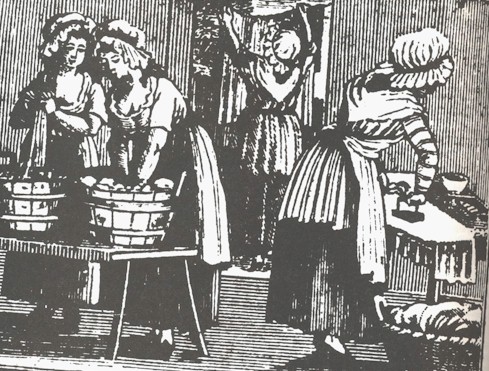
http://www.oocities.org/homespunlhg/18Cfashion01.htm
This illustration shows typical working women. They wear petticoats, bed jackets, caps, kerchiefs, shifts, and aprons. There is very little fitting involved in 18th century clothing, and most everything is made from simple squares and rectangles of fabric, with the exception of underarm gussets which can be triangle-shaped. It is generally not necessary to have a pattern if you can enlarge from a graphed drawing, or if you have someone who can help you with this. Please inquire if you need assistance, or see the following approved books:
Tidings from the 18th Century. Gilgun, Beth. ISBN 1-880655-04-7. This book is made up of a series of fictitious first person letters. Each letter describes an article of clothing, cookware, or some aspect of 18th century material culture. It is reasonably priced, well researched and well written, and something you will refer to often as you develop and improve your impression.
Fitting and Proper. Burnston, Sharon Ann. ISBN 1-880655-10-1. Sharon has filled this helpful book with photos of clothing from the 18th century collection of the Chester County Historical Society and supplemented it with excellent graphed patterns and descriptions of the clothing. Seeing original garments is the best way to recreate an accurate wardrobe. As they say, “A picture is worth a thousand words”. This book will be of tremendous help in understanding and making 18th century clothing.
Everyday Dress of Rural America, 1783-1800. Wright, Meredith. ISBN 0-9625656-0-1. The author has done an excellent job in illustrating each piece of clothing for women, men, and children, and has provided easy to work with graphs to use as patterns. She has also included sewing instructions and descriptions of the sometimes unfamiliar garment names.
With any one of these books, or better still all three of them, and a supply of 1 inch graphed paper purchased from a sewing supply store to use in reproducing the patterns from the drawings the need for purchased patterns is eliminated. When Anne and I first started making clothing we purchased three patterns and to date have not used any one of the three, using instead patterns made from these graphed drawings.
We found the instructions too difficult to decipher, or the patterns not historically accurate enough to suit us once we got them and gave them a serious going-over.
Fabrics should be wool, cotton, linen, or silk, or some combination thereof – no synthetics, and be careful of your colors and patterns. Checks or plaids should be woven and not stamped. Stripes are a good choice, with the stripes going vertical whenever possible.
PETTICOAT: A petticoat might today be called a skirt. Women wore them in multiples, one serving the purpose of a petticoat in the true sense of the word, the outer one serving as an outer garment.
STAYS: Stays are the 18th century version of a boned corset. They sometimes have shoulder straps, sometimes not. They have a distinctive shape which molds the body differently from the 19th century corset. They have tab skirts at the bottom which fit over the hips. It is not mandatory to wear stays for a working impression since it can be documented working women often did not.
JUMPS: This garment is worn by some women as an outer garment, however, it is not documented historically accurate for outer wear. It is generally accepted that these are undergarments, and worn as such under a jacket or short gown. They should be cut long in length to fit over the hips with the petticoat coming over the top of the lower portion of the jumps. They provide support when needed without the rigidity of stays.
BED JACKET OR SHORT GOWN: These loose jackets are held together with pins or by tying the apron around the waist. There are no buttons or hooks and eye closures. The bed jacket is not something worn to bed or to lounge, but rather an outer garment often seen in illustrations and paintings. The short gown is also open down the front with no closures. It is shorter than the bed jacket which is generally mid-thigh length. The jackets have sleeves, however, they are not always long sleeves. The sleeves were sometimes removable and taken off for working in hot weather. Both types of jackets are cut in the shape of a “T”, in one piece if possible, and stitched down each side. The sleeves can be pieced, and in fact, many originals survive which have been pieced in ingenious ways in order to have enough fabric to make the garment.
CAPS: The circular gathered “mob” cap is not correct. Please see the above books for photos and illustrations of period correct caps. Most women wore caps on their heads. Peter Kalm wrote, “All women in the country without exception wear caps of some kind or other”. Most caps are made of fine cotton or linen, and are white. In place of a cap a woman working outdoors might wear a kerchief on her head.
NECKERCHIEF: These are approximately 30-34 in. square and worn about the neck. They later evolved into the fichu of the 19th century. They may be triangle shaped, or square folded corner to corner. They can be made of cotton or linen for summer, and heavier fabric or wool for winter. They can be worn tied, pinned, or tucked into the front of a bodice.
APRONS: 18th century aprons are not nearly as full as those of the 19th century. Since few women wear 19th century aprons full enough perhaps some could be recycled. They have narrow cotton tape for ties which when worn wraps around the back, back to the front and is tied in front.
SHIFT: A shift is the 18th century term for what became known as the chemise in the next century. The basic shape is no different except that the sleeves are elbow length. It can have a ruffle or not at the neck to suit the wearer’s preference.
FOOTWARE: Working women may go barefoot, weather permitting, or wear an appropriate documented style of moccasin, especially if your impression is Native American or Celtic. 18th century shoes had a distinctive shape and heel so ask, and do your homework before investing in a pair.
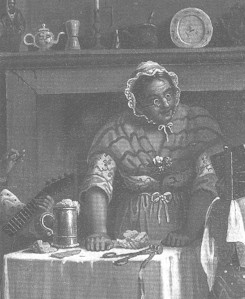
This woman wears a correctly shaped cap tied under the chin, a petticoat, jacket, and apron tied in front. The narrow tape ties are visible at her waist. The neckerchief is pinned with some type of broach. The patterns and colors of her clothing are not “matched”.
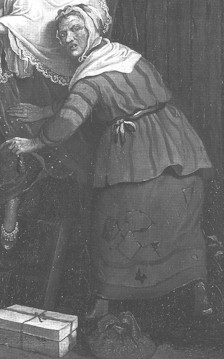
This rather homely woman wears a petticoat, striped bed jacket, neckerchief, and cap. Her petticoat is well mended. She also wears her cap tied underneath the chin.
Old friends are hard to part with. The 18th century bed jacket did not fade into oblivion at the stroke of the clock with the coming of the 19th century. The following illustration was published in 1850, and the garment the woman is wearing would be period correct for 18th century wear, or by changing the name by which the garment was known from bed jacket to sack or sacque it remains correct through the 1860’s. The sack was sometimes decorated and trimmed and worn for traveling or other activity through the 1850’s, but by the 1860’s was evolving into more of a working garment.
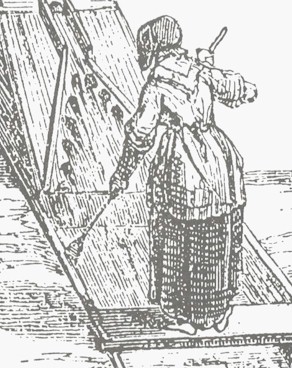

This fishwife wears a petticoat, bed jacket, neckerchief, cap, and shoes while she works. This illustration dates to the 1830’s.
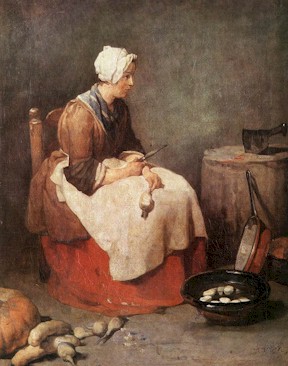
This painting shows a woman involved in kitchen work dressed just as the illustrations above depict. The paintings show colors that the illustrations do not.
As a general rule 18th century clothing is easier and quicker to sew though it should be hand-sewn, and roomier and much more comfortable to wear.
No comments:
Post a Comment